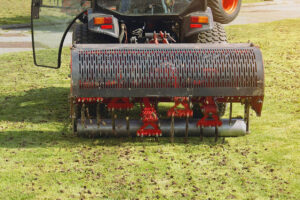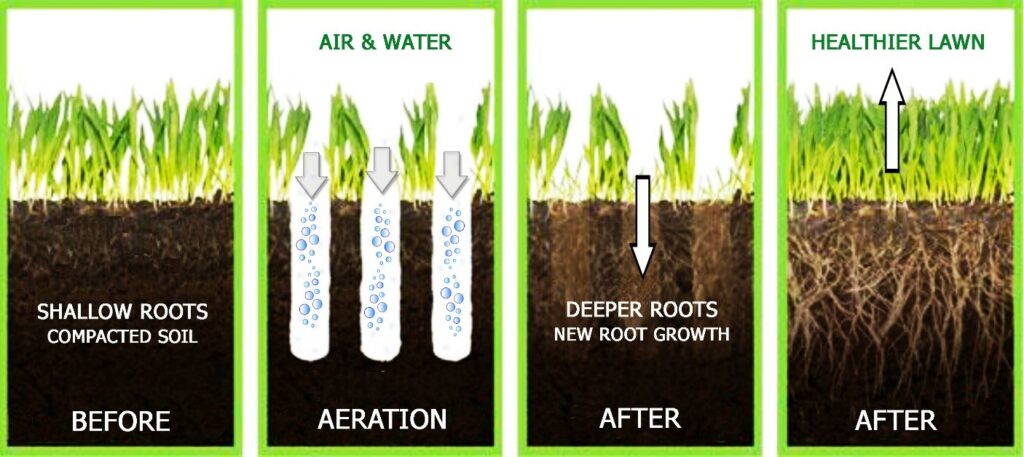
What is Lawn Aeration?
Aeration is a process that involves creating small holes in the lawn to alleviate soil compaction and improve the circulation of air, water, and nutrients to the grassroots. Over time, foot traffic, outdoor projects, and weather conditions can lead to soil compaction, which restricts the movement of essential elements within the soil. Aeration helps to reverse this compaction, allowing the grassroots to receive the necessary oxygen, water, and nutrients for healthy growth.
The Benefits of Lawn Aeration
Aeration offers numerous benefits that contribute to the overall health and appearance of your lawn:
- Improved Soil Drainage: Compacted soil prevents proper drainage, leading to waterlogging and poor root health. Aeration helps to alleviate soil compaction, allowing excess water to drain effectively.
- Enhanced Nutrient Absorption: When the soil is compacted, nutrients struggle to reach the grassroots. Aeration creates channels for nutrients to penetrate the soil, ensuring optimal nutrient absorption.
- Stronger and Deeper Root Growth: Aerated soil provides an environment that promotes strong and deep root growth. Deep roots are more resilient to drought, disease, and other stressors, resulting in a healthier and more robust lawn.
- Thatch Reduction: Thatch, a layer of organic matter that accumulates between the grass and the soil surface, can hinder root growth and impede nutrient absorption. Aeration helps to break down thatch, enabling better access to the soil for grassroots.
Now that we understand the importance and benefits of lawn aeration, let’s delve into the different methods of aeration and explore the most effective techniques.
Methods of Aeration
Several methods of aeration exist, including spike aeration, blade aeration, liquid aeration, and core aeration. Among these, core aeration is widely considered the most effective and popular method for achieving optimal results.
Core Aeration
Core aeration, also known as plug aeration, involves the removal of small plugs or cores of soil from the lawn. This process creates openings in the soil, allowing for improved air and water circulation. Here’s how core aeration works:
- Equipment: Core aeration can be done manually using a manual aerator or aeration machine. A manual aerator consists of hollow tines that are pushed into the ground to remove plugs of soil. A powered aeration machine, such as a gas-powered or electric aerator, is more efficient for larger lawns.
- Plug Size and Spacing: The soil plugs removed during core aeration are typically 2 to 4 inches deep and 0.5 to 0.75 inches in diameter. These plugs are spaced approximately 2 to 3 inches apart from each other.
- Process: The aerator is operated over the lawn, systematically covering the entire area. As the aerator removes the plugs of soil, it creates open channels for air, water, and nutrients to reach the grassroots.
Core aeration is a highly effective method for relieving soil compaction and promoting overall lawn health. Now that we understand core aeration, let’s explore when and why you should aerate your lawn.
When and Why Should You Aerate Your Lawn?
Aeration should be performed when your lawn exhibits signs of soil compaction or other related issues. Here are some factors to consider when determining if your lawn needs aeration:
- Heavy Foot Traffic: If your lawn receives significant foot traffic, such as being used as a playground or racetrack, it can lead to soil compaction. Aeration helps alleviate this compaction, ensuring proper air and water circulation.
- Newly Constructed Lawns: Lawns that were established as part of newly constructed homes often experience soil compaction due to construction traffic. Aeration is crucial to reverse the effects of this compaction and promote healthy root development.
- Excessive Thatch: Thatch buildup can create a barrier between the grassroots and essential elements like air, water, and nutrients. If your lawn has a thatch layer greater than one-half inch, aeration is recommended to break down the thatch and promote optimal nutrient absorption.
- Spongy or Dry Lawn: A lawn that dries out easily and has a spongy feel may indicate excessive thatch or soil compaction. Aeration can address these issues, improving water infiltration and preventing waterlogging.
Timing is key when it comes to aeration. It’s best to aerate your lawn during the growing season when the grass can heal and fill in any open areas left by the soil plugs. The timing varies depending on the type of grass you have:
- Cool Season Grasses: For lawns with cool-season grasses like bluegrasses, fescues, and ryes, late summer or fall is an ideal time for aeration. These grasses have withstood the summer heat and are in a state of steady growth during this period.
- Warm Season Grasses: Lawns with warm-season grasses, such as zoysia grass or Bermuda grass, should be aerated in late spring or early summer. These grasses are actively growing during this time, allowing for optimal recovery after aeration.
Now that we’ve covered the timing and benefits of aeration let’s explore the different tools you can use for aeration.
Tools for Aeration
A variety of tools are available for aerating your lawn, each with its own advantages and limitations. The two main types of aerating tools are spike aerators and plug aerators.
Spike Aerators
Spike aerators feature solid tines or forks that penetrate the soil, creating holes without removing soil cores. While spike aerators are a more affordable option, they are less effective compared to plug aerators. Spike aeration can actually cause additional compaction around the holes, reducing its overall effectiveness.
Plug Aerators
Plug aerators, also known as core aerators, are the preferred choice for optimal lawn aeration. These machines remove small soil cores from the lawn, creating openings for air, water, and nutrients to penetrate the soil. Plug aerators provide more significant benefits compared to spike aerators by relieving soil compaction and promoting healthier grassroots.
When using a plug aerator, look for machines that remove soil cores approximately 2 to 3 inches deep and 0.5 to 0.75 inches in diameter. These machines can be rented from lawn and garden stores or home improvement centers. Consider sharing the rental cost with a neighbor who is also interested in aerating their lawn to save money.
How to Aerate Your Lawn
Now that we have covered the basics of aeration, let’s dive into the step-by-step process of aerating your lawn effectively:
- Choose the Right Time: As discussed earlier, the timing of aeration depends on the type of grass you have. For cool-season grasses, the best time to aerate is late summer or fall. For warm-season grasses, aim for late spring or early summer.
- Prepare the Lawn: Before aerating, ensure that the soil is adequately moist. Aerate the day after a rain shower or water your lawn the day before to avoid aerating dry and hard soil.
- Aerate the Lawn: Using a plug aerator, systematically cover the entire area of your lawn. Make multiple passes over heavily compacted areas to ensure proper aeration.
- Deal with Soil Plugs: After aerating, the soil plugs should be allowed to dry. Once dry, you can break them up to give your lawn a uniform appearance. This can be done by running them over with a lawn mower or using the back of a rake. Properly dispose of the broken soil plugs.
- Follow Up with Lawn Care: After aerating, it’s essential to continue with regular lawn care practices such as proper fertilizing, mowing, and watering. This will help your lawn recover and thrive after the aeration process.
It’s important to note that aeration should be paired with other lawn care practices to maximize its benefits. Applying fertilizer immediately after aeration allows the nutrients to reach the grassroots more effectively. Additionally, reseeding your lawn after aeration can help fill in any open areas and promote even growth. However, make sure to remove any cored pieces of soil from the lawn to prevent uneven seed growth.
Aeration is a vital practice for maintaining a healthy and vibrant lawn. By creating openings in the soil, aeration allows air, water, and nutrients to reach the grassroots, promoting strong root growth and overall lawn health. Whether you choose to aerate your lawn manually with a fork or invest in a plug aerator, the benefits of aeration are well worth the effort.
Remember to consider the specific needs of your lawn, including the type of grass, soil conditions, and lawn usage, to determine the ideal timing and frequency of aeration. By incorporating aeration into your lawn care routine, you can enjoy a lush and thriving lawn that will be the envy of the neighborhood.
So, don’t overlook the importance of aeration in your lawn care regimen. Give your lawn the breath of fresh air it deserves, and watch it flourish into a beautiful and healthy landscape.
Contact us (859-314-LAWN) for more information or a free instant quote!
—
 About Green & Grow
About Green & Grow
Green & Grow is a full service lawn care company specializing in lawn mowing, fertilization & weed control, aeration & seeding, insect control, and more!
> Learn More


 About Green & Grow
About Green & Grow